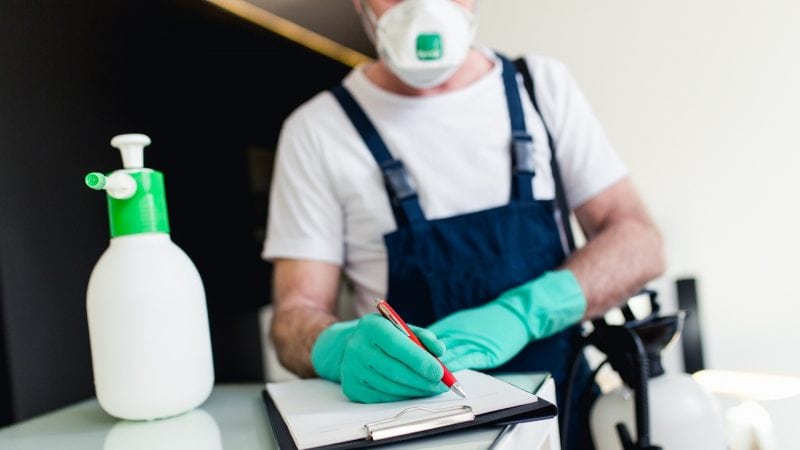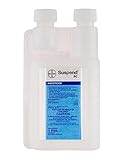The fastest way to stop a bed bug infestation, aside from heat or cold treatment, is to use deadly chemicals. If we take a look at the EPA’s regulation of bed bug pesticides, we can see that around 300 different pesticide products are registered. This means that you have a whole arsenal of chemicals at your disposal to start a chemical war against bed bugs.
What chemicals kill bed bugs? Chemicals that are used in pesticide products for eradicating bed bugs are divided into 7 different chemical classes:
- Pyrethrins and Pyrethroids
- Desiccants
- Biochemicals
- Neonicotinoids
- Pyrroles
- Insect Growth Regulators
The most popular chemical classes that are used for getting rid of bed bugs are pyrethrins and pyrethroids. Other chemicals are used less but are still effective. In this article, we’re going to go into detail about the most common pesticides used for killing bed bugs.
Do You Need Chemicals to Kill Bed Bugs?
In most cases, no. For many people with a low-to-average infestation, diatomaceous earth is more than enough to kill all the bed bugs.
However, if you’re the unlucky person who has bed bugs that are resistant to some of the pesticides and on top of that, you don’t have money to pay for the exterminator, then you can consider all the chemicals we’ve mentioned. Still, you need to be very careful when using them and always wear the required equipment.
As for diatomaceous earth, you can always buy a 5 lb bag and see if it works for you. Eight times out of ten, we guarantee you’ll be able to eliminate a huge portion of the infestation.
If you don’t like chemicals or you think they are too dangerous you can always use other methods like heat treatment for bed bugs. This is the most efficient method on the market but it costs more and requires more equipment. Usually, it is done by professional exterminators. There is also a cold bed bug treatment but this one is pretty delicate and should be avoided if you don’t know what you are doing.
Potential Risks of Using Chemicals

Using any kind of chemicals in your house poses a certain risk. Just think about your typical soap or dishwashing agent. What happens if it gets in contact with your eyes, for example? Your eyes start to hurt and you need to go to the doctor.
Logically, chemicals that kill bed bugs are far more dangerous and can cause health problems ranging from mild to severe. Chemicals in the form of powder can easily be scattered around and come in contact with your skin. This can potentially lead to rashes and irritation, especially for those with sensitive skin.
On the contrary to that, some substances can cause lung problems if inhaled, the prime example being bed bug sprays. The mouth and eyes are especially prone to these problems, as they have the best absorbing characteristics. For that reason, always carefully read the declaration on the chemical you bought, despite what people tell you on the internet always trust the instructions.
If it says that you need a fumigation mask, then go and buy the fumigation mask. Other equipment includes different face masks, gloves, and goggles. Also, we suggest wearing long sleeves, as they will prevent you from coming into contact with the chemical you’re applying.
What Chemicals Kill Bed Bugs?
Pyrethrins and Pyrethroids

Pyrethrins and pyrethroids are vastly used for killing bed bugs around the globe and in many cases, these are the substances that a professional exterminator will use to destroy bed bug infestations. That being said, they are the most popular and the most effective for killing not only bed bugs but also other types of pests.
- Broad-spectrum control of more than 50 nuisance pests
- Effective knockdown with a long residual
- No odor, no visible residue
- Package Dimensions: 3.1 L x 27.7 H x 18.0 W (centimeters)
Let’s start with pyrethrins. Pyrethrins are derived from chrysanthemum flowers and are botanical insecticides, whereas pyrethroids are synthetically-made insecticides that act like pyrethrins. Nevertheless, both of them are known to cause some serious damage to bed bugs, flushing them out from their hiding spots and killing them quickly.
Since pyrethrins and pyrethroids are so vastly used, some bed bugs developed a certain degree of resistance to them. Due to their resistance, these substances won’t always kill bed bugs but make them move to another place, e.g. hiding spot.
To remedy this, professionals came to the idea to use a combination of several products – active pyrethroid and pyrethrin ingredients. This can further improve the effectiveness but still, if some of the bed bug infestations get resistant to the substance, it is not guaranteed that all of them will die. Still, for bed bugs that aren’t resistant to pyrethrins and pyrethroids, these substances can wreak havoc.
Desiccants
Desiccant is a substance that works a bit differently than the aforementioned ones. It’s a substance for killing bed bugs that takes a bit of time to start having an effect. However, the immediate effect is the peeling of the waxy protective skin on a bed bug. When this skin is eliminated, bed bugs start to dehydrate and slowly die a rather painful death.
For a bed bug exterminator, desiccants are a must-have and there’s a reason for that. The reason is that bed bugs can’t get become resistant to desiccants, unlike typical pesticides. Also, because its effect is slower, it’s long-lasting, meaning that it can kill bed bugs in the long run.
Does diatomaceous earth ring any bells? It’s a typical desiccant that we all use to combat bed bugs, alongside boric acid, which is rarely used. When using desiccants, be sure that the particular product is EPA-registered and labeled as safe for use!
- Natural Product - Composed of 2lbs of 100% ground freshwater...
- OMRI Listed - Listed with the Organic Minerals Research...
- Powder Duster Included - Powder duster in the bag for easy and...
- Supports a Great Cause - Harris donates 10% of profits to support...
- Made in the USA – Mined in Nevada and packaged in Georgia
Beware that there’s one more type of diatomaceous earth, the food-grade one, which is used for food and swimming pools. Even though it’s food-grade, it still represents a risk to people if inhaled! For that reason, use desiccants only for cracks and holes.
Biochemicals
Of all biochemicals, only one is EPA-registered for use against bed bugs, and it’s cold-pressed neem oil. If you’ve read some of our previous articles, you know that we recommended using neem oil for dispatching bed bugs in cracks and crevices.
Neem oil comes from the seeds of the neem tree, which can be found in Africa and Southeast Asia. The oil from this tree comes with a plethora of pest-killing compounds that have some amazing medicinal properties, aside from killing bed bugs. Furthermore, neem oil is also used in making soaps, toothpaste, shampoos, and cosmetics.
- ✅ Neem Oil - Milania Neem Oil is authentic, pure, natural, and...
- ✅ Just one ingredient - Pure Neem Oil, natural, cold-pressed.
- ✅ Providing with the friendliest customer service is our number...
- ✅ Organic - Cold-pressed - Vegan - Gluten-free - No...
Despite its wide use, neem oil isn’t dangerous for humans, as it is for bed bugs. The bed bug control using neem oil showed excellent results, with the oil being able to kill nymphs, adults, and bed bug eggs. Those who want a natural bed bug pesticide should look for cold-pressed neem oil.
Neonicotinoids
If neonicotinoids sound to you like it has to do something with nicotine, you’re right. This substance is a pure synthetic form of nicotine that attacks the nicotinic receptors and makes the nerves go on fire, to the point of failure. Since this substance uses a different mode of action, bed bugs can’t become resistant to it, so you can always kill them with this substance.
Pyrroles
The only pyrrole pesticide you can get that is EPA-registered is chlorfenapyr. The biological activity of chlorfenapyr relies on activation where the substance forms another chemical, making this substance a pro-insecticide. This new chemical works by attacking the bed bug cells and disrupting vital functions, which causes a slow and painful death. This is a very effective bed bug pesticide.
Insect Growth Regulators
Insect growth regulators might sound a bit spooky, given the fact that they can alter the bug’s development. But, don’t be spooked, as this substance will be used against bed bugs, and not against you. Insect growth regulators are a substitute for growth hormones in insects and they work by altering the insect’s development from juvenile to adult.
- Pyridine 1. 30%
- I. G. Regulator is for use in kennels, doghouses, carpet,...
- 1 ounce per gallon of water
Alternatively, some growth regulators inhibit the production of chitin, which is a substance used for creating the external shell of bed bugs. With that in mind, some growth regulators will stop the development, while others might make bed bugs grow too rapidly. Either way, both are equally dangerous and deadly for bed bugs.
A typical example of a high-potent insect growth regulator is hydroprene. It’s used for destroying bed bug nests, even in cases of highly-populated infestation. By preventing adult bugs from reproducing, hydroprene slowly reduces the bed bug population, making them smaller each day.
Accompanied by, for example, diatomaceous earth, this product can both prevent reproduction and kill the remaining bed bugs at the same time. Generally speaking, hydroprene is safe for pets and humans, so you can use whatever form you like – aerosolized, solid, or liquid.
Related: Top 10 Bed Bug Sprays | Safest and Most Effective Options
List of Sources
EPA Regulation of Bed Bug Pesticides. United States Environmental Protection Agency.
Bedbugs. Mayo Clinic.
Koehler, P.G., Pereira R. M., Pfiester, M., Hertz, J. ( 2011). Bed bugs and blood-sucking conenose. EDIS.
- How to Get Rid of Copperheads | Practical Guide - August 27, 2023
- How to Get Rid of Corn Snakes | What Makes Them Aggressive? - August 27, 2023
- How to Get Rid of Alligators | Safety Measures and Removal Methods - July 16, 2023




